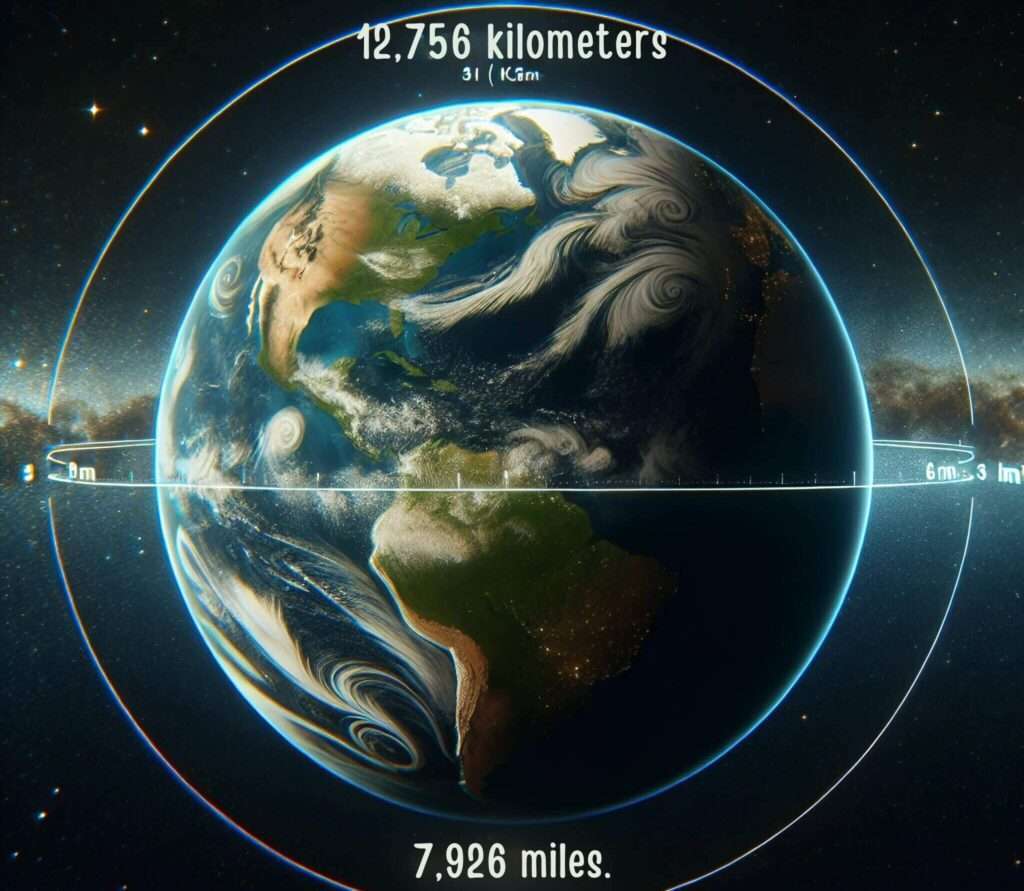Earth is a fascinating planet with a unique form that scientists have meticulously measured. Its flattened shape at the poles and bulging at the equator creates an oblate spheroid structure.
As Earth spins on its axis, the centrifugal force causes a slight bulge in the equatorial region, making it more comprehensive than the distance from pole to pole. These precise measurements are crucial for scientific calculations in various fields, including geology, meteorology, and aerospace engineering.
Accurate geographic measurements help in navigation, creating maps, and utilizing satellite positioning systems like GPS. Let’s explore how these essential figures shape our understanding of the planet we inhabit.
Earth’s Diameter and Radius: Fundamental Measurements
Understanding Earth’s dimensions is crucial for grasping its size and shape. The key measurements include the equatorial diameter, approximately 12,742 kilometers or 7,918 miles, and the polar diameter, measuring about 12,714 kilometers or 7,926 miles. The difference between these two diameters is about 28 kilometers or 17 miles, highlighting how Earth’s rotation and the bulge at the equator influence its form.
The average radius is a standard reference point in scientific calculations and models, providing a mean measurement essential for understanding celestial bodies and their dynamics. The planet’s oblate spheroid shape means its greatest diameter occurs at the equator, while its reduced polar diameter results from the flattening effect of centrifugal force caused by its rotation. This variation in diameter is significant for navigational systems and geographic information systems (GIS), relying on precise measurements to ensure accuracy in mapping and positioning.
Accurate knowledge of Earth’s gravitational forces also aids scientific disciplines such as geology, meteorology, and space exploration. It helps us understand climate patterns and the planet’s internal structure and dynamics, enriching our overall comprehension of how Earth functions within the universe.
Earth’s Circumference Measurement
Due to its oblate spheroid shape, Earth’s circumference varies slightly depending on where it is measured. Two key measurements are commonly used: the equatorial circumference and the meridional circumference.
- Equatorial circumference: ~40,075 kilometers (24,901 miles)
This is the circumference measured along the equator, the widest part of the Earth.
- Meridional circumference: ~40,008 kilometers (24,860 miles)
This slight difference results from the flattening at the poles caused by Earth’s rotation.
Earth Measurement Methods:
Historically, early measurements were made using simple geometry. Eratosthenes, a scholar in ancient Greece around 240 BCE, used the sun’s shadows in Alexandria and Syene to estimate Earth’s size. His ingenious method involved triangulation and the assumption that Earth was a sphere. Modern geodesy has improved these ancient methods with precise measurements by using theodolites, angles, and ground-based measurements that account for terrain irregularities and elevation.
Today, satellites and GPS (Global Positioning System) technology provide even more accuracy. Satellites send signals to receivers on the ground, helping scientists track tectonic movements and detect gravitational anomalies. These advanced tools allow for continuous refinement of Earth’s measurements, ensuring precision across fields like navigation and geophysics.
Earth’s Surface Area: A Global Overview
Earth’s total surface area spans approximately 510 million square kilometers or 197 million square miles, divided between oceans and land.
Oceans:71% (361 million square kilometers / 139 million square miles)
- The oceans dominate Earth’s surface, influencing weather systems, global temperature regulation, and water cycles.
- The Pacific Ocean alone spans 168 million square kilometers, making it the largest ocean. Oceans have rich marine ecosystems, providing food, oxygen, and climate regulation through carbon absorption.
Land:29% (149 million square kilometers / 58 million square miles)
- Earth’s landmass consists of diverse terrains, including mountains, forests, deserts, and plains. These environments support a variety of ecosystems, ranging from tropical rainforests to arctic tundras, contributing to Earth’s rich biodiversity.
The division of Earth’s surface between land and oceans creates diverse ecosystems that support life globally. Marine ecosystems host countless organisms, ranging from microscopic plankton to massive whales. Terrestrial ecosystems provide habitats for millions of plants, animals, and fungi. These ecosystems exhibit unique distribution patterns, driving biodiversity across regions.
Energy flow throughout the planet is closely tied to these ecosystems. Oceans are crucial as climate stabilizers, regulating heat absorption and redistribution. This impacts atmospheric conditions and shapes weather patterns. On land, regions like forests, deserts, and grasslands interact with sunlight, water, and nutrients to sustain various species.
However, scientists warn that human activities disrupt ecosystems and threaten biodiversity worldwide. Conservation efforts are essential to protect these delicate systems from further harm and ensure a balance between ecosystems and the changing environment.
Earth’s Volume and Mass: How They Are Measured
Earth’s volume and mass are essential to understanding its structure and the gravitational force that governs our interactions within our solar system. These measurements provide crucial insights into Earth’s internal composition and the physical phenomena that affect our daily lives, such as atmospheric conditions and tides.
Volume: 1 Trillion Cubic Kilometers (260 Billion Cubic Miles)
Earth’s volume is estimated at 1 trillion cubic kilometers (260 billion cubic miles). This measurement accounts for the planet’s space, including the solid crust, mantle, and core. Determining Earth’s volume helps scientists model its internal structure and predict phenomena like tectonic movements and volcanic activity.
The calculation of Earth’s volume assumes it is an oblate spheroid, with the volume formula:

Where:
- a = equatorial radius (6,378 km)
- b = polar radius (6,357 km)
Mass: 5.97 × 10²⁴ kg
Earth’s mass is approximately 5.97 × 10²⁴ kilograms. This mass includes all of Earth’s components, from the solid crust to the liquid outer core and dense inner core. Measuring Earth’s mass is possible by observing its gravitational interactions with other celestial bodies, such as the Moon and satellites in orbit.
Gravitational Pull and Earth’s Density
Earth’s gravitational pull is directly related to its mass and density. On the surface, the average acceleration due to gravity is 9.8 m/s². Gravity keeps objects grounded and binds the atmosphere to the planet.
Earth’s average density is 5.51 g/cm³, making it the densest planet in the solar system. This high density reflects the presence of heavy elements like iron and nickel, primarily found in Earth’s core. The distribution of this mass affects Earth’s shape and gravitational field, contributing to phenomena like tides and satellite orbits.
The Vastness of Earth’s Oceans
Earth is often called the “Blue Planet” due to the overwhelming presence of water covering about 71% of its surface. Earth’s oceans are crucial in shaping weather patterns, regulating the climate, and supporting diverse marine ecosystems.
Pacific Ocean
The Pacific Ocean is the largest and deepest ocean, spanning about 168 million square kilometers. Its depths reach an astonishing 11,000 meters (around 36,000 feet) at the Mariana Trench, making it a key player in global weather systems. Phenomena such as El Niño and La Niña originate from this immense size, influencing extreme weather events across the globe.
Atlantic Ocean
The Atlantic Ocean, covering 85 million square kilometers, is the second-largest and is vital for its oceanic currents, such as the Gulf Stream, which regulates the climate of the northeastern United States and northwestern Europe.
Indian Ocean
The Indian Ocean, at 70 million square kilometers, ranks as the third-largest ocean and is crucial for influencing regional climates, particularly monsoon patterns in South Asia. Its waters serve as a critical route for global trade and house unique marine ecosystems, including coral reefs and affluent fishing areas. Ocean size and depth significantly impact weather and aquatic life, moderating temperatures and creating stable climatic conditions.
How Earth Compares to Other Planets
Earth’s size and dimensions provide context for comparing it with the other planets in our solar system. While Earth is one of the larger terrestrial planets, its size and characteristics contrast significantly with those of its neighbouring terrestrial planets and the massive gas giants.
Size Comparison with Terrestrial Planets
- Mercury: 4,879 km diameter
Mercury is the most minor planet in the solar system, with a diameter less than half that of Earth. Its compact size and proximity to the Sun result in extreme temperature fluctuations, ranging from scorching heat to freezing cold. Unlike Earth, Mercury has a fragile atmosphere, contributing to its inhospitable environment.
- Venus: 12,104 km diameter
Often called Earth’s “sister planet” due to its similar size and composition, Venus has a slightly smaller diameter than Earth’s (12,742 km). Despite this similarity, Venus presents a vastly different environment, characterized by a thick, toxic atmosphere and surface temperatures hot enough to melt lead. These conditions make it one of the most extreme environments in the solar system.
- Mars: 6,779 km diameter
Mars, the fourth planet from the Sun, is approximately 53% the diameter of Earth. Known as the “Red Planet,” Mars has a thin atmosphere and experiences seasons similar to Earth’s. Due to evidence of past water flow, Mars is of great interest to scientists and researchers, making it a candidate for future exploration and potential colonization.
Earth vs. Gas Giants
In stark contrast to terrestrial planets, Earth is significantly smaller than the gas giants, which include Jupiter, Saturn, Uranus, and Neptune.
- Jupiter: 142,984 km diameter
Jupiter is the most giant planet in the solar system, with a diameter over 11 times larger than Earth. Its massive size and gas composition (mainly hydrogen and helium) lead to a dense atmosphere with powerful storms, such as the Great Red Spot. Jupiter’s sheer size influences many aspects of the solar system, including the orbits of other celestial bodies.
- Saturn: 120,536 km diameter
Known for its stunning rings, Saturn is another gas giant much more significant than Earth. Its size and mass contribute to its intense gravitational field, affecting its many moons and the surrounding environment.
If you enjoy exploring dimensions or you are a dimension lover, then start reading the detailed Dimensions of Football Field.
Read This >> What Are the Dimensions of a Football Field? A Detailed Breakdown
Conclusion
Understanding Earth’s dimensions fosters curiosity and is fundamental to comprehend the planet’s characteristics and behavior. This knowledge is significant in the broader context of the solar system. Earth’s oblate spheroid shape and vast surface area contribute to its unique profile that supports life. These dimensions influence numerous natural processes, from diameter and radius to the differences between the equatorial and polar dimensions.
Earth’s circumference, measured around the equator and poles, emphasizes its unique shape and has implications for navigation and geography. By studying Earth’s volume and mass, we gain remarkable insights into gravitational forces and density, which are essential scientific principles. Land and ocean surface areas play a significant role in climate regulation and biodiversity, enhancing our understanding of how Earth compares to other planets.
In this comparison, Earth is a modest player among the terrestrial planets, often dwarfed by gas giants that showcase planetary forms and compositions. Recognizing these complexities within Earth’s dimensions also instills a sense of responsibility to protect our remarkable planet.
Frequently Asked Questions
1. What is the diameter of Earth?
The diameter of Earth varies depending on where it is measured. The equatorial diameter is approximately 12,742 kilometers (7,918 miles), while the polar diameter is about 12,714 kilometers (7,900 miles).
2. How big is Earth compared to other planets?
Earth is the fifth-largest planet in our solar system. It is larger than Mercury, Mars, and Venus but significantly smaller than gas giants Jupiter (142,984 km) and Saturn (120,536 km).
3. What is the circumference of Earth?
Earth’s equatorial circumference is approximately 40,075 kilometers (24,901 miles), while its meridional circumference (around the poles) is about 40,008 kilometers (24,860 miles).
4. How do scientists measure Earth’s dimensions?
Scientists use various methods to measure Earth’s dimensions, including ancient calculations (like those by Eratosthenes), geodesic triangulation techniques, and modern satellite measurements through GPS technology.
5. How large are Earth’s oceans?
Earth’s oceans cover approximately 361 million square kilometers (139 million square miles), which accounts for about 71% of the planet’s surface area. The largest ocean is the Pacific Ocean, followed by the Atlantic and Indian Oceans.
6. What is the volume of Earth?
Earth’s volume is approximately 1 trillion cubic kilometers (260 billion cubic miles), which includes the space occupied by the planet’s solid crust, mantle, and core.
7. What is Earth’s mass and density?
Earth’s mass is approximately 5.97 × 10²⁴ kilograms, and its average density is about 5.51 g/cm³, making it the densest planet in the solar system. This high density reflects the presence of heavy elements, primarily found in Earth’s core.











